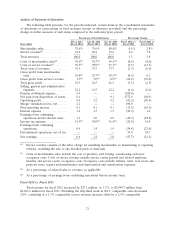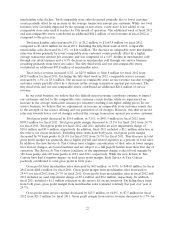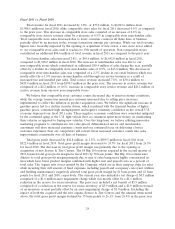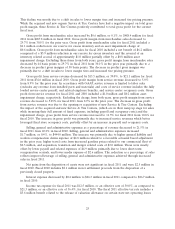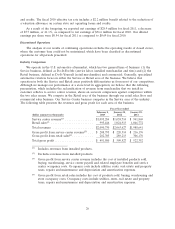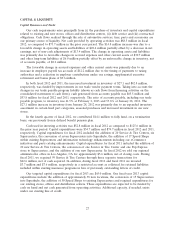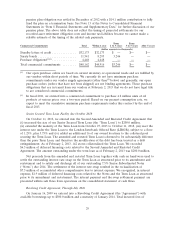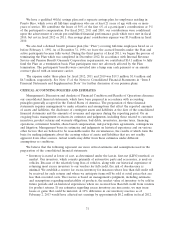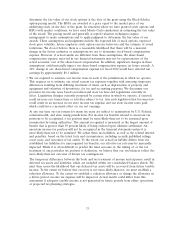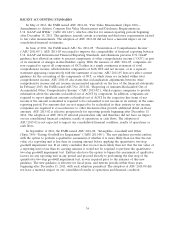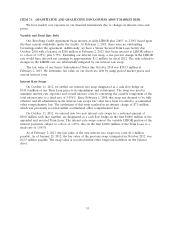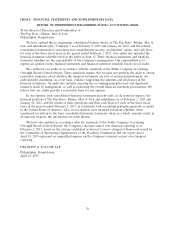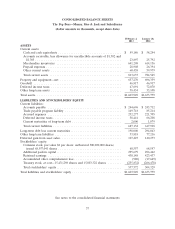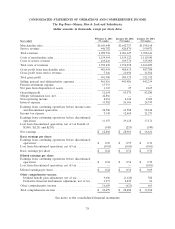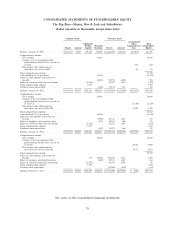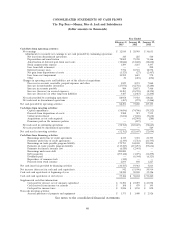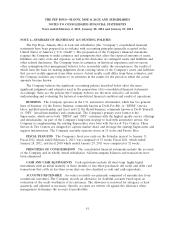Pep Boys 2012 Annual Report Download - page 70
Download and view the complete annual report
Please find page 70 of the 2012 Pep Boys annual report below. You can navigate through the pages in the report by either clicking on the pages listed below, or by using the keyword search tool below to find specific information within the annual report.We have a qualified 401(k) savings plan and a separate savings plan for employees residing in
Puerto Rico, which cover all full-time employees who are at least 21 years of age with one or more
years of service. We contribute the lesser of 50% of the first 6% of a participant’s contributions or 3%
of the participant’s compensation. For fiscal 2012, 2011 and 2010, our contributions were conditional
upon the achievement of certain pre-established financial performance goals which were met in fiscal
2010, but not in fiscal 2012 or 2011. Our savings plans’ contribution expense was $3.0 million in fiscal
2010.
We also had a defined benefit pension plan (the ‘‘Plan’’) covering full-time employees hired on or
before February 1, 1992. As of December 31, 1996, we froze the accrued benefits under the Plan and
active participants became fully vested. During the third quarter of fiscal 2011, we began the process of
terminating the Plan which was completed in December 2012. In accordance with Internal Revenue
Service and Pension Benefit Guaranty Corporation requirements, we contributed $14.1 million to fully
fund the Plan on a termination basis. Plan participants were not adversely affected by the Plan
termination. The participants’ benefits were converted into a lump sum cash payment or an annuity
contract placed with an insurance carrier.
The expense under these plans for fiscal 2012, 2011 and 2010 was $19.3 million, $1.4 million and
$6.3 million, respectively. See Note 13 of the Notes to Consolidated Financial Statements in ‘‘Item 8
Financial Statements and Supplementary Data’’ for further discussion of our pension plans.
CRITICAL ACCOUNTING POLICIES AND ESTIMATES
Management’s Discussion and Analysis of Financial Condition and Results of Operations discusses
our consolidated financial statements, which have been prepared in accordance with accounting
principles generally accepted in the United States of America. The preparation of these financial
statements requires management to make estimates and assumptions that affect the reported amounts
of assets and liabilities, the disclosure of contingent assets and liabilities at the date of the consolidated
financial statements and the amounts of revenues and expenses during the reporting period. On an
on-going basis, management evaluates its estimates and judgments, including those related to customer
incentives, product returns and warranty obligations, bad debts, inventories, income taxes, financing
operations, retirement benefits, share-based compensation, risk participation agreements, contingencies
and litigation. Management bases its estimates and judgments on historical experience and on various
other factors that are believed to be reasonable under the circumstances, the results of which form the
basis for making judgments about the carrying values of assets and liabilities that are not readily
apparent from other sources. Actual results may differ from these estimates under different
assumptions or conditions.
We believe that the following represent our more critical estimates and assumptions used in the
preparation of the consolidated financial statements:
• Inventory is stated at lower of cost, as determined under the last-in, first-out (LIFO) method, or
market. Our inventory, which consists primarily of automotive parts and accessories, is used on
vehicles. Because of the relatively long lives of vehicles, along with our historical experience of
returning most excess inventory to our vendors for full credit, the risk of obsolescence is
minimal. We establish a reserve for excess inventory for instances where less than full credit will
be received for such returns and where we anticipate items will be sold at retail prices that are
less than recorded costs. The reserve is based on management’s judgment, including estimates
and assumptions regarding marketability of products, the market value of inventory to be sold in
future periods and on historical experiences where we received less than full credit from vendors
for product returns. If our estimates regarding excess inventory are inaccurate, we may incur
losses or gains that could be material. A 10% difference in our inventory reserves as of
February 2, 2013 would have affected net earnings by approximately $0.2 million in fiscal 2012.
31


